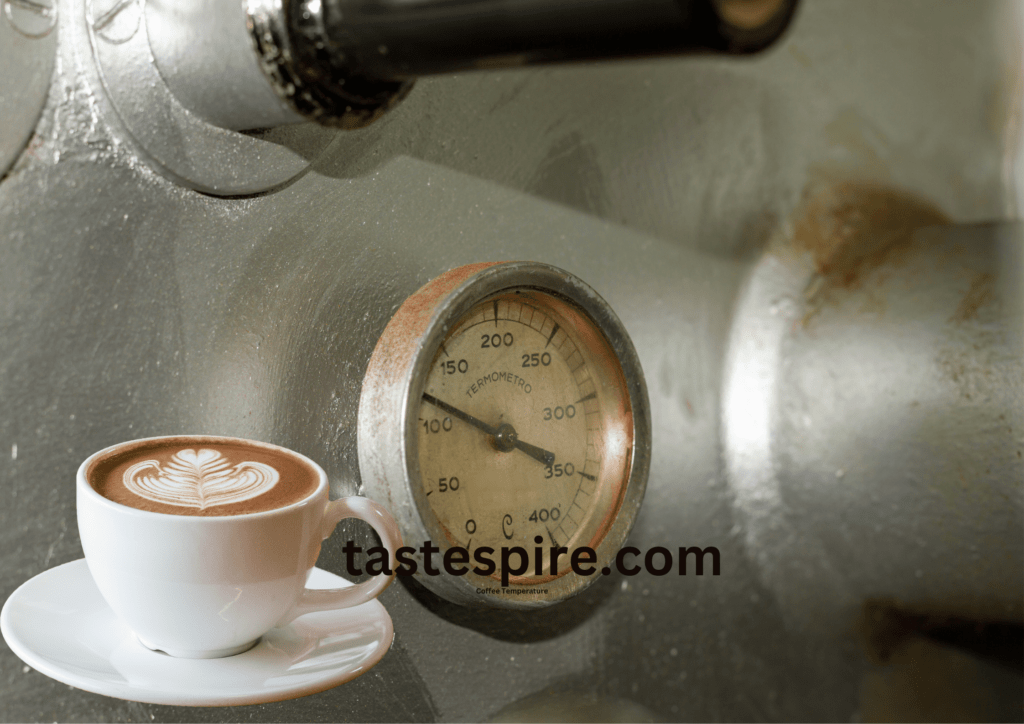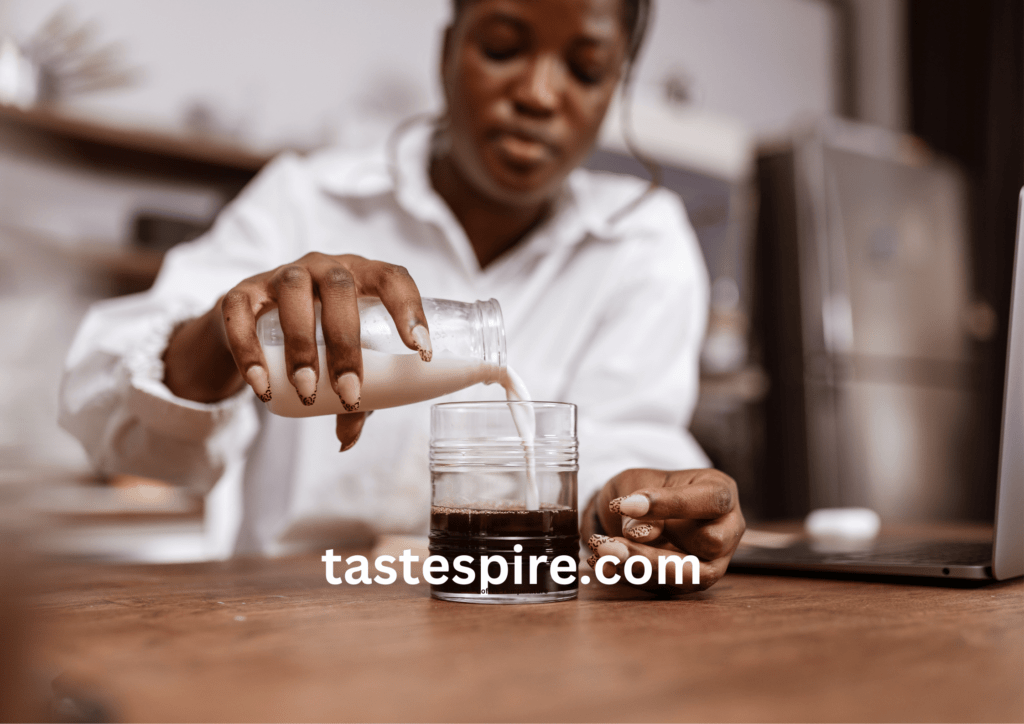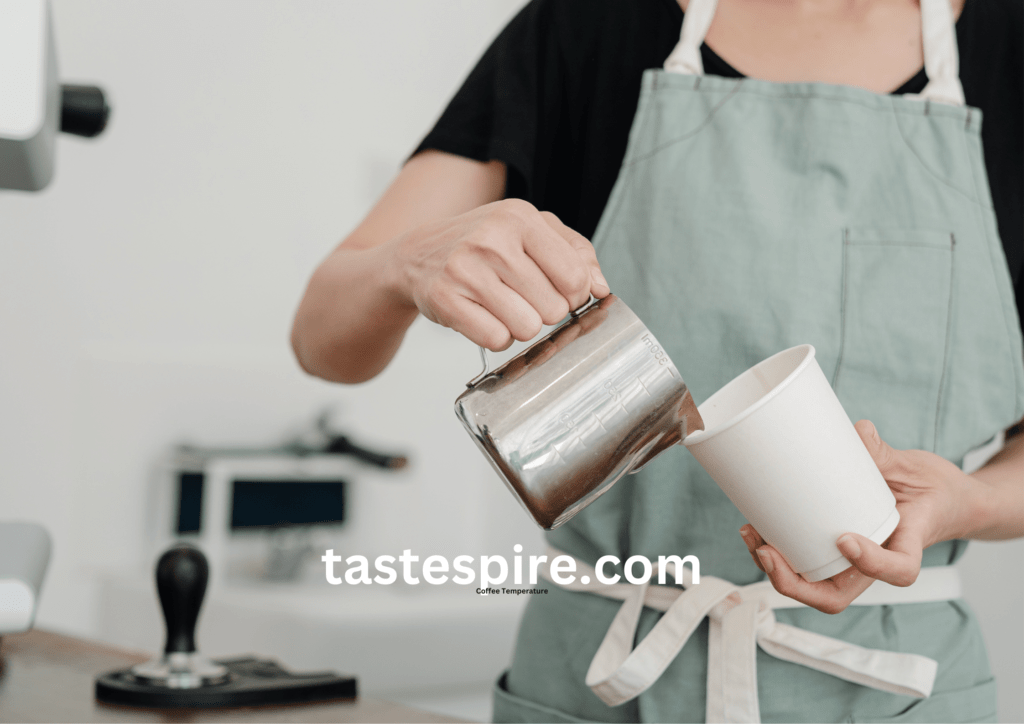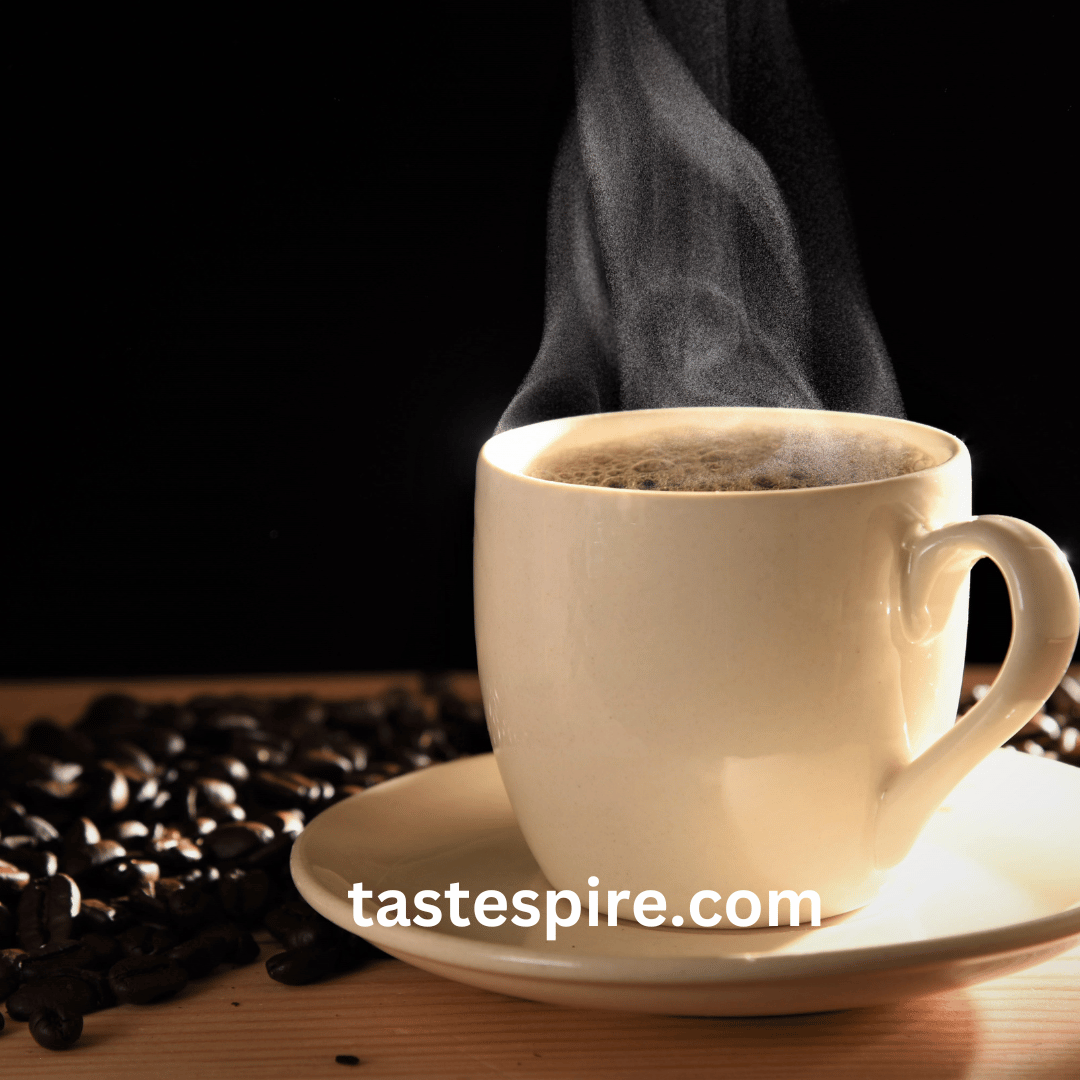Coffee brings people together worldwide with its delightful aroma and energizing taste. Whether it’s your morning routine an afternoon boost or a companion during evening chats coffee is a cherished part of our lives. But have you ever stopped to think about How Hot Is Coffee should be to truly enjoy it?
In this detailed guide we’ll explore the world of coffee temperatures and how they impact your coffee experience. From finding the right temperature for serving to understanding the science behind temperature preferences we’ll unravel the mysteries that waft from your cup. Join us as we venture through the ins and outs of coffee temperatures uncovering the secrets to achieving the perfect balance of warmth and flavor. So let’s begin our journey by answering the questions that’s been on your mind What’s the ideal temperature for a perfect cup of coffee? How hot is coffee supposed to be? etc
Understanding Coffee Temperature: Defining the Ideal Temperature for Coffee and the Science Behind Preferences

Before we dive into the intricate details of coffee temperature let’s begin by defining what constitutes the ideal temperature for this beloved beverage. Coffee temperature isn’t merely a matter of personal preference it significantly impacts the flavors aromas and overall experience of each sip.
Defining the Ideal Temperature for Coffee
- The National Coffee Association suggests that the optimal serving temperature for coffee lies between 180 to 185 degrees Fahrenheit. This standard practice ensures that the coffee is served hot enough to be enjoyed while avoiding scalding temperatures that can lead to burns. However the perfect coffee temperature is not a one-size-fits-all concept. Factors such as individual taste preferences coffee bean quality and brewing methods play a role in determining the ideal temperature.
The Science Behind Coffee Temperature Preferences
- Unveiling the science behind coffee temperature preferences offers insights into how our taste buds and sensory perceptions interact with different temperature ranges. Studies have shown that the perception of sweetness and bitterness is amplified at higher temperatures while sourness and saltiness become more pronounced at lower temperatures. These findings provide a basis for understanding why some prefer their coffee piping hot while others opt for a cooler experience.
- Coffee’s complex flavor profile is influenced by various compounds that are released at different temperatures. Finding the right balance allows us to unlock the unique notes and subtleties that each coffee variety offers. By understanding the interplay between temperature and taste we can make more informed choices about how we enjoy our coffee.
In the following sections we’ll explore the nuances of coffee temperature further considering both brewing and serving temperatures and how they contribute to the overall coffee experience. We’ll also discuss effective methods for cooling down your coffee without compromising on flavor as well as remedies for those unfortunate moments when a sip is a little too eager and leaves you with a burnt tongue. Stay with us as we navigate the intricate landscape of coffee temperature, striving to uncover the ultimate balance that enhances every cup.
Variability in Coffee Temperature: Factors That Shape Personal Preferences and The National Coffee Association’s Recommended Temperature
Now that we’ve established the significance of coffee temperature let’s explore the factors that contribute to the variability in personal preferences and delve into the temperature range recommended by the National Coffee Association.
Factors Influencing Personal Temperature Preferences
- Why do some individuals relish their coffee at scalding temperatures while others prefer a milder warmth? The answer lies in a combination of factors that affect our sensory experience and taste perception. Scientific studies indicate that taste sensitivity genetics cultural influences, and personal habits all contribute to our preferred coffee temperature.
The National Coffee Association’s Suggested Temperature
- For those seeking a guideline on the ideal temperature for coffee the National Coffee Association recommends a range of 180 to 185 degrees Fahrenheit. This range strikes a balance between serving coffee hot enough to be satisfying and avoiding temperatures that could lead to burns.
However it’s essential to recognize that coffee temperature preferences are not set in stone. Different coffee varieties brewing methods and roast profiles can alter the optimal temperature for each cup. As you navigate the realm of coffee temperature keep in mind that flexibility and experimentation are key to finding your perfect brew.
Stay tuned as we proceed to unravel the intricate relationship between brewing and serving temperatures and how they contribute to the flavors and aromas that define the coffee experience. We’ll also share valuable insights on cooling down your coffee without compromising on taste and offer remedies for moments when your eagerness leads to a burnt tongue. Let’s continue our journey through the realm of coffee temperature and its captivating complexities.
Brewing vs. Serving Temperature: Navigating the Distinction

Before we further unravel the intricate world of coffee temperature let’s first differentiate between the brewing and serving temperatures. Understanding this distinction is fundamental to appreciating the various aspects of coffee’s journey from bean to cup.
Distinguishing Between Brewing and Serving Temperatures
- Brewing temperature refers to the heat at which water comes into contact with coffee grounds during the brewing process. It plays a pivotal role in extracting the flavors aromas and essential compounds that transform coffee into the beloved beverage we know. The recommended brewing temperature typically falls between 195 to 205 degrees Fahrenheit (90 to 96 degrees Celsius), ensuring a delicate balance between proper extraction and avoiding undesirable flavors.
- On the other hand serving temperature pertains to the heat at which the final cup of coffee is presented for consumption. This is the point at which personal preferences come into play as different temperatures can enhance or diminish the nuances of the coffee’s flavor profile.
The Importance of Optimal Brewing Temperature (195-205°F)
- The temperature at which brewing occurs is the crucial factor in revealing the complete range of flavors naturally present in coffee beans. Temperatures too low may result in under-extraction leading to a weak and watery brew devoid of depth. On the contrary excessively high temperatures risk over-extraction yielding a bitter and harsh taste that masks the coffee’s natural character.
- Hence maintaining an optimal brewing temperature between 195 to 205 degrees Fahrenheit is essential. This range ensures the extraction of desirable compounds such as oils and solubles while minimizing the extraction of bitter and undesirable compounds.
- Intriguingly the brewing temperature doesn’t directly correlate with the serving temperature. A brewing temperature that optimizes extraction might not necessarily produce the most enjoyable cup at the same temperature. As we explore further we’ll uncover the nuances between brewing and serving temperatures shedding light on how they collectively shape our coffee experience.
Stay with us as we continue our exploration delving into the delicate art of achieving the ideal serving temperature to enhance the sensory delight of every sip. We’ll also unravel the secrets of cooling down your coffee without sacrificing flavor and provide insights into managing tongue burns caused by impatience. The journey through the realm of coffee temperature continues revealing hidden facets of this cherished beverage’s world.
Finding the Perfect Serving Temperature: Balancing Taste and Safety

As we venture deeper into the realm of coffee temperature we arrive at the juncture where taste and safety intersect. Achieving the perfect serving temperature is a delicate balance that harmonizes flavor perception and ensuring a safe and enjoyable coffee experience.
Balancing Taste and Safety in Serving Temperature
- The National Coffee Association suggests a serving temperature of 180 to 185 degrees Fahrenheit (82 to 85 degrees Celsius). This range widely adopted in the coffee industry takes into consideration both flavor enhancement and safety. However it’s important to recognize that individual preferences may vary and this range provides a starting point rather than a strict rule.
- Beyond the general recommendation there exists a realm of subjectivity where personal taste reigns supreme. The temperature at which you enjoy your coffee profoundly influences how you perceive its flavors aromas and nuances. Striking the right balance ensures that your coffee remains palatable while guarding against the risks of scalding.
The Impact of Coffee Temperature on Flavor Perception
- The relationship between coffee temperature and flavor perception is intricate and nuanced. Scientific studies reveal that higher serving temperatures amplify perceptions of sweetness and bitterness while lower temperatures emphasize sourness and saltiness. This interplay between temperature and taste underscores the importance of selecting a temperature that aligns with your desired flavor profile.
- For those who prefer the rounded sweet and bitter notes in their coffee the range of 155 to 175 degrees Fahrenheit might be ideal. On the other hand if you find enjoyment in the brighter sharper and more acidic facets of your brew, consider aiming for 120 to 140 degrees Fahrenheit.
As we navigate the spectrum of coffee temperatures we unearth the significance of temperature as a flavor-enhancing tool. The nuances of temperature play a pivotal role in either revealing or masking the intricate flavors that lie within every cup of coffee. Join us as we continue our exploration delving into practical ways to cool down your coffee without diluting its essence and discovering remedies for the all-too-familiar experience of a burnt tongue. Our quest to decode the mysteries of coffee temperature continues guiding us toward crafting the perfect coffee moment.
Different Approaches to Serving Temperature: Preferred Ranges for Unique Coffee Qualities
As we journey further into the realm of coffee temperature we unearth various approaches to serving temperature that cater to distinct coffee qualities. Each approach presents a unique perspective on how temperature can enhance the flavor and overall coffee experience. Let’s explore these approaches and discover the ideal temperature ranges for different coffee qualities.
Optimal Range for Rounded, Sweet, and Bitter Notes (155-175°F)
- Coffee aficionados seeking a harmonious blend of rounded sweet and bitter notes often find their coffee nirvana within the temperature range of 155 to 175 degrees Fahrenheit (68 to 79 degrees Celsius). This temperature zone unlocks a symphony of flavors that dance across your taste buds creating a balanced and pleasing sensation.
The Delicate Nuances Range (120-140°F)
- For those who cherish the delicate nuances and intricate subtleties hidden within each coffee bean the temperature range of 120 to 140 degrees Fahrenheit (49 to 60 degrees Celsius) is the sweet spot. Within this range the coffee’s personality truly shines revealing layers of flavors that might be overshadowed by higher temperatures. This approach invites you to savor every sip and appreciate the artistry of coffee crafting.
The Warming Sensation Range (180-185°F)
- Some coffee enthusiasts prioritize the comforting warmth that a cup of coffee brings embracing the soothing sensation it offers. The range of 180 to 185 degrees Fahrenheit (82 to 85 degrees Celsius) caters to this preference, enveloping you in a cocoon of warmth as you sip your brew. This temperature range provides a tactile experience that complements the coffee’s flavor profile, creating a holistic and cozy moment.
Here’s a table summarizing the different approaches to serving temperature and their corresponding ideal temperature ranges for distinct coffee qualities:
| Approach | Ideal Temperature Range | Coffee Qualities Emphasized |
|---|---|---|
| Optimal Range for Rounded, Sweet, and Bitter Notes | 155-175°F (68-79°C) | Harmonious blend of rounded, sweet, and bitter notes |
| The Delicate Nuances Range | 120-140°F (49-60°C) | Unveiling intricate coffee nuances |
| The Warming Sensation Range | 180-185°F (82-85°C) | Embracing comforting warmth and flavor |
As we navigate the diverse landscape of serving temperatures we gain insights into the intricate interplay between temperature and taste. The temperature you choose becomes a tool for shaping your coffee experience allowing you to emphasize certain characteristics while muting others. By understanding these nuanced approaches you can tailor your coffee temperature to align perfectly with your palate and preferences.
Join us as we continue our exploration delving into practical methods to cool down your coffee for immediate enjoyment and uncovering remedies to alleviate the discomfort of a burnt tongue. Our journey through the world of coffee temperature continues guiding us toward crafting the ultimate coffee ritual that resonates with our individual tastes and desires.
Methods to Cool Down Coffee:
The Common Problem of Hot Coffee Burns
- It’s a scenario many of us can relate to you’re craving that first sip of your morning coffee but it’s scorching hot. Drinking it too quickly can result in a painful burn on your tongue. Fortunately there are effective ways to cool down your coffee without compromising on taste.
Effective Cooling Methods Beyond Adding Milk
- While adding milk is a common way to cool down coffee there are other methods you can try to achieve the perfect sipping temperature.
Blowing on the Coffee
- One of the simplest ways to cool down your coffee is to blow on it gently. This helps dissipate the heat from the surface and can make the first sip more bearable.
Adding Milk

- Adding a small amount of milk to your coffee can help lower its temperature. Milk not only cools the coffee down but also adds a creamy texture and flavor.
Stirring the Coffee
- Stirring your coffee with a spoon or stirring stick can help distribute the heat more evenly allowing it to cool faster.
Pouring Between Cups

- Pouring your coffee back and forth between two cups can accelerate the cooling process by exposing it to more air. Just be cautious when transferring to avoid spills.
The Art of Waiting for Natural Cooling
- If none of the immediate cooling methods suit your taste you can always opt for the age-old practice of waiting. Allowing your coffee to cool naturally takes time but it ensures that you’ll enjoy your coffee at a safe and enjoyable temperature.
By using these effective cooling methods you can avoid the discomfort of hot coffee burns and savor your favorite beverage at the perfect temperature.
Coping with Burnt Tongue:
Understanding Tongue Burns and Healing Process
- Experiencing a burnt tongue from sipping hot coffee can be quite unpleasant. However the good news is that tongue burns typically heal relatively quickly due to the rich blood supply in the tongue area.
Avoiding Hot Foods and Beverages
- To help your burnt tongue heal effectively it’s essential to avoid further irritation. This means steering clear of not only hot beverages but also hot foods. Additionally you should stay away from spicy and acidic foods like tomatoes and citrus which can exacerbate the discomfort.
Trying Saltwater Rinses for Relief
One simple and effective way to find relief from a burnt tongue is by using a saltwater rinse. Here’s how you can do it:
- Take a cup of warm water.
- Add about a teaspoon of salt and mix it until dissolved.
- Gargle the saltwater mixture in your mouth ensuring it comes into contact with the burnt area.
- Hold the mixture in your mouth for a few seconds before spitting it out.
Saltwater rinses can help prevent infection and soothe the irritated area promoting faster healing. This method can be particularly helpful in providing temporary relief from the discomfort of a burnt tongue.
By understanding how to cope with a burnt tongue and taking these simple steps you can ease the healing process and find comfort while waiting for your tongue to recover.
The Joy of Enjoying Coffee at the Right Temperature:
Striking the Balance Between Hot and Cold
- When it comes to coffee temperature plays a crucial role in the overall experience. Finding that sweet spot between scalding hot and lukewarm is essential for savoring the true essence of your favorite brew.
- Coffee enthusiasts know that the perfect temperature can unlock a world of flavors and aromas. Whether you’re a morning sipper an afternoon indulger or an after-dinner coffee connoisseur getting the temperature right can make all the difference.
Savoring the Pleasure of the Perfect Cup of Coffee
- Imagine taking that first satisfying sip of coffee where the warmth envelops you without scorching your taste buds. It’s like discovering a symphony of flavors dancing on your palate the delicate notes of bitterness and sweetness the subtle hints of acidity and the comforting aroma that fills the air.
- By understanding the nuances of coffee temperature from brewing to serving and sipping you can elevate your coffee-drinking experience to a whole new level. With the right temperature you’ll find yourself savoring each moment whether you’re enjoying a quiet morning alone or sharing a cup with friends.
Remember the joy of coffee goes beyond just the caffeine kick it’s about relishing every sip embracing the warmth and finding that perfect balance that makes each cup a delightful journey of flavors and sensations. So take a moment appreciate the art of temperature, and let your coffee-loving heart revel in the pleasure of the perfect cup.
How Hot Is Coffee? Answer in short
Coffee temperatures vary based on brewing and serving preferences. Brewing temperatures typically range between 195 and 205°F (90-96°C) while serving temperatures span 120 to 185°F (49-85°C). The ideal temperature for enjoying coffee’s flavors is subjective with ranges like 155-175°F (68-80°C) for balanced taste and 120-140°F (49-60°C) for nuanced notes.
FAQs: Common Questions about Coffee Temperature and their Answered
Q: What is the temperature of coffee?
The temperature of coffee can vary depending on how it’s brewed and served. Generally coffee is brewed at temperatures between 195 and 205 degrees Fahrenheit (90-96 degrees Celsius). However the serving temperature can range from around 120 to 185 degrees Fahrenheit (49-85 degrees Celsius) depending on personal preferences.
Q: How hot is coffee at Starbucks?
At Starbucks the typical serving temperature for coffee is around 160 to 185 degrees Fahrenheit (71-85 degrees Celsius). This range is generally consistent with industry standards for serving hot beverages.
Q: What is the temperature of coffee Celsius?
The temperature of coffee in Celsius can range from approximately 49 to 85 degrees Celsius when served. Brewing temperatures can be between 90 and 96 degrees Celsius.
Q: How hot does coffee need to be to burn?
Coffee temperatures above 160 degrees Fahrenheit (71 degrees Celsius) have the potential to scald and cause burns. The severity of a burn can vary based on factors such as the individual’s sensitivity to heat and the length of contact.
Q: What is the perfect temperature for coffee?
The “perfect” temperature for coffee varies among individuals based on taste preferences. However a common consensus suggests that the range between 155 and 175 degrees Fahrenheit (68-80 degrees Celsius) is optimal for balanced taste and enjoyment.
Q: How hot is McDonald’s coffee now?
McDonald’s coffee is typically served at a temperature within the industry standard range of 160 to 185 degrees Fahrenheit (71-85 degrees Celsius).
Q: Is 200 degrees too hot for coffee?
Yes 200 degrees Fahrenheit (93 degrees Celsius) is considered too hot for brewing or serving coffee. Water temperatures above 205 degrees Fahrenheit (96 degrees Celsius) can scald the coffee grounds and result in a burnt taste.
Q: What temperature degree Celsius is coffee?
Coffee can be brewed at temperatures ranging from 90 to 96 degrees Celsius. When served coffee temperatures can be anywhere from 49 to 85 degrees Celsius depending on personal preferences and safety considerations.
Q: What is the ideal temperature for serving coffee?
The National Coffee Association recommends a serving temperature of 180 to 185 degrees Fahrenheit (82 to 85 degrees Celsius). However personal preferences vary and finding your ideal temperature within this range is key to a satisfying coffee experience.
Q: Does the brewing temperature affect the taste of coffee?
Absolutely! Brewing temperature significantly impacts the flavor profile of your coffee. The recommended temperature range for brewing coffee falls within 195 to 205 degrees Fahrenheit (approximately 90 to 96 degrees Celsius). Brewing hotter can lead to burnt flavors while brewing cooler can result in under-extraction and weak taste.
Q: How does coffee temperature influence flavor perception?
Coffee’s flavors are most pronounced when served at around 140 degrees Fahrenheit (60 degrees Celsius). Higher temperatures can mask delicate nuances while temperatures above 150 degrees Fahrenheit (65 degrees Celsius) might overpower flavors.
Q: Can I cool down coffee without affecting its taste?
Yes there are effective methods to cool down hot coffee without compromising its taste. Blowing on your coffee adding milk stirring it or pouring it between cups can all help achieve a drinkable temperature while preserving its flavors.
Q: What should I do if I burn my tongue on hot coffee?
Tongue burns from hot coffee can be painful. To aid the healing process avoid hot foods and drinks including spicy and acidic items. A saltwater rinse created by mixing a teaspoon of salt in a cup of water can help prevent infection and promote healing.
Q: How can I enjoy my coffee at the right temperature?
Striking the balance between scalding hot and too cool is essential. Depending on your preference for flavor notes, you can aim for specific temperature ranges. For well-rounded notes target 155 to 175 degrees Fahrenheit (68 to 80 degrees Celsius) or opt for a more delicate experience at 120 to 140 degrees Fahrenheit (49 to 60 degrees Celsius). If the warming sensation is your priority consider 180 to 185 degrees Fahrenheit (82 to 85 degrees Celsius).
Q: Is coffee temperature a personal preference?
Yes, coffee temperature is highly subjective. Your ideal temperature depends on your taste buds flavor preferences and the type of experience you seek from your cup of coffee.
Q: Can I enjoy coffee at a temperature other than hot or cold?
Absolutely! Coffee can be enjoyed at various temperatures and the choice is yours. Whether you prefer your coffee piping hot warm or even iced exploring different temperatures can provide unique taste experiences.
Conclusion:
Embrace the Temperature Spectrum of Coffee
- Coffee’s allure lies not just in its flavor but also in the intricate dance of temperature that defines its essence. From the moment coffee is brewed to the point it touches your lips temperature plays a pivotal role in shaping your experience. By understanding the delicate balance between heat and taste you open the door to a world of coffee enjoyment like never before.
- As we’ve explored the ideal temperature for serving coffee varies from person to person. The National Coffee Association’s suggestion of 180 to 185 degrees Fahrenheit provides a reliable starting point. However your personal preference might lead you to the rounded sweet and bitter notes of the 155 to 175 degrees Fahrenheit range or perhaps the delicate nuances that emerge between 120 and 140 degrees Fahrenheit. And if the warming sensation is your cup of tea err coffee 180 to 185 degrees Fahrenheit could be your sweet spot.
- Cooling methods such as blowing on your coffee or adding milk can help bridge the gap between scalding and sippable. And if you’ve ever suffered a burnt tongue from overeager sips our remedies can provide soothing relief and a quick return to coffee indulgence.
- In the end coffee temperature is a journey of discovery one where experimenting with different ranges adds layers of depth to your understanding. As you sip and savor pay attention to how temperature influences your perception of flavors. Whether it’s the bright acidity of a cooler cup or the warm comfort of a well balanced brew each temperature range offers a unique adventure for your taste buds.
So whether you’re a fan of piping hot cups chilled brews or the wonderful in-between remember that the world of coffee is vast and diverse. Embrace the full range of temperatures delve into their marvels and set out on a delightful expedition that honors the craftsmanship of preparing coffee. From the science of brewing to the joy of sipping temperature is your companion guiding you towards your perfect cup of coffee. Cheers to finding your coffee’s sweet spot and to the countless warm (or cool) moments it brings to your life!
Read more of our informative blogposts at
